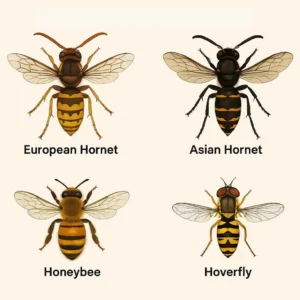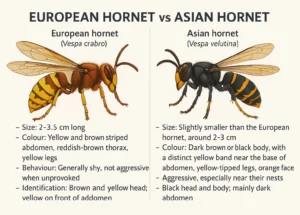Hornets in the UK: How to Identify and Protect Against Invasive Species
According to the British Association for Shooting and Conservation (BASC), Asian hornets can decimate pollinator populations. This isn’t just bad news for bees — it’s bad news for us too, as pollinators are essential for food crops and wild plants.
The species is classed as invasive, meaning it poses a threat to native biodiversity. The UK Government is working to contain and eradicate Asian hornets, but public awareness is key.
Hornets are often misunderstood. While their size and loud buzz can be intimidating, these fascinating insects play an important role in our ecosystems – especially the native European hornet. However, the recent arrival of the invasive Asian hornet poses a real threat to our pollinators.
The Asian hornet is a problem because it preys on honeybees and other pollinators, potentially disrupting ecosystems and damaging honeybee populations.
In this blog, we’ll look at how to tell the difference between species, when you’re most likely to see them, and what to do if you spot an invasive hornet.
What does a European hornet look like?
The European hornet (Vespa crabro) is the UK’s only native hornet species.
- Size: 2–3.5cm long
- Colour: Brown and yellow striped abdomen, reddish-brown thorax, yellow legs
- Behaviour: Generally shy and not aggressive unless threatened, especially away from the nest
- Benefits: They feed on flies, caterpillars, and other insects, helping to control pest numbers
European hornets are most active from late spring to early autumn. They are mostly seen during the day but can be attracted to lights at night.
How to identify an Asian hornet
The Asian hornet (Vespa velutina) is not native to the UK.
- Size: Slightly smaller than the European hornet, around 2–3cm
- Colour: Dark brown or black body, with a distinct yellow band near the base of the abdomen, yellow-tipped legs, and an orange face
- Behaviour: Highly effective predator of honeybees and other pollinators
Asian hornets were first spotted in the UK in 2016. They spread quickly and can cause severe damage to bee colonies.
Two wings or four? The quick way to tell hornets, wasps, and bees from flies

- Hornets, wasps, and bees all have four wings — two forewings and two hindwings. The hindwings are smaller and hook onto the forewings with tiny hooks called hamuli, so they move together in flight and can look like just one pair.
- Flies (including bee and wasp mimics like hoverflies) have only two wings. Their second pair has evolved into small, knob-like structures called halteres, which act as flight stabilisers.
If you can see four wings, you’re looking at a true hornet, wasp, or bee.
What to do if you spot an Asian hornet
If you think you’ve seen an Asian hornet:
- Stay safe — do not disturb or approach the nest
- Take a clear photo if possible
- Report it immediately via the UK’s Asian Hornet Watch app or at The UK Government reporting page
When are hornets active in the UK?
Hornets are most active from May to October, with numbers peaking in late summer. Queens emerge in spring to start new colonies, while workers are busiest during warmer months. Nests usually die off by late autumn, with only new queens surviving to the following year.
Hornets in Rockford’s World

For example, the laughing owl of New Zealand once filled the night with its eerie, human-like call. It vanished by the early 20th century, driven to extinction by habitat loss and predators such as stoats, cats, and rats — all animals introduced by humans. If Infinity were real, the laughing owl would be there, preserved as the last of its kind.
Just as the laughing owl fell victim to invasive predators, Asian hornets threaten our pollinators today. Preventing their spread is vital if we want to keep native wildlife from following the same path to Infinity.
In summary
- European hornets are large, shy, and helpful insect predators
- Asian hornets are invasive and harmful to pollinators
- Knowing the difference — and counting the wings — helps protect UK wildlife
🌿🍃🌼🌿🍃🌼🌿🍃🌼🌿🍃🌼🌿🍃🌼🌿🍃🌼🌿🍃🌼🌿🍃🌼🌿🍃
Tune In and Explore More with Rockford’s Rock Opera
Looking for stories and songs that bring the natural world to life? Join us on the “Stories, Science, and Secrets” podcast where we explore amazing examples of biomimicry and nature’s clever solutions to big problems.
Plus, download FREE lesson plans and slides on extinction, biomimicry, and more — perfect for families and educators who want to turn nature walks into learning adventures.
✨ The fully illustrated book of Lost on Infinity is OUT NOW! ✨
Available to buy in our shop and on Amazon. It includes free QR Code links to our award-winning audiobook, songs, and sound effects, so you can listen and read-along together.


